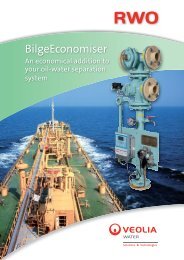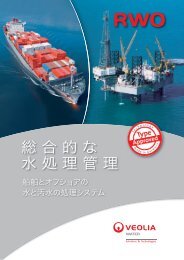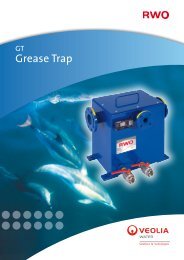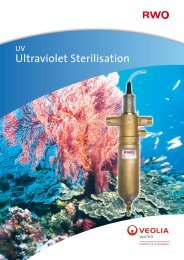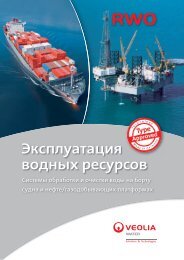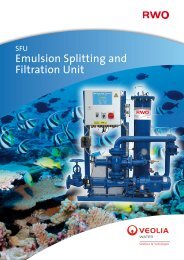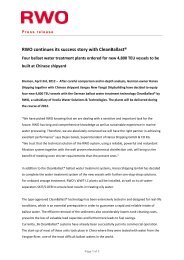the IHS Ballast Water Guide - RWO Marine Water Technology
the IHS Ballast Water Guide - RWO Marine Water Technology
the IHS Ballast Water Guide - RWO Marine Water Technology
Create successful ePaper yourself
Turn your PDF publications into a flip-book with our unique Google optimized e-Paper software.
Sponsored by <strong>IHS</strong> Fairplay Solutions <strong>Guide</strong> to <strong>Ballast</strong> <strong>Water</strong> Treatment Systems<br />
Blue<strong>Ballast</strong><br />
Nutech O3/NK Co 8<br />
The Blue<strong>Ballast</strong> system from Arlington,<br />
Virginia-based Nutech O3 injects ozone<br />
into a ship’s ballast water, as it is taken onboard<br />
<strong>the</strong> ship. In seawater, <strong>the</strong> ozone will<br />
kill approximately half <strong>the</strong> invasive species<br />
on contact. The ozone also interacts with<br />
chemicals that naturally occur in seawater to<br />
create various bromine compounds that kill<br />
<strong>the</strong> remaining invasive species.<br />
Ozone, as a gas, is not stored on <strong>the</strong><br />
vessel but is made by taking ambient air<br />
and stripping out <strong>the</strong> nitrogen, cooling it,<br />
<strong>the</strong>reby concentrating <strong>the</strong> oxygen. It is<br />
<strong>the</strong>n hit with a 10kV charge of electricity<br />
which converts 10% of <strong>the</strong> concentrated<br />
oxygen into ozone. The ozone is immediately<br />
injected into <strong>the</strong> ballast water intake pipe as<br />
<strong>the</strong> water is taken on board.<br />
Once it is injected into <strong>the</strong> ballast water,<br />
<strong>the</strong> ozone reverts to oxygen within just five<br />
seconds. Before it reverts to oxygen,<br />
however, <strong>the</strong> ozone converts<br />
bromine, which occurs<br />
naturally in<br />
Mark II OceanSaver is now ready<br />
seawater, into hypobromous acid.<br />
Trace quantities of bromine compounds,<br />
known as total residual oxidants (TRO) prove<br />
to regulatory authorities that <strong>the</strong> ballast water<br />
has been properly treated. Testing for TRO is<br />
a straightforward process that can be handled<br />
by most crew members.<br />
To avoid any possibility of accidental<br />
damage, <strong>the</strong> oxygen storage tank is located in a<br />
protected space. As an extra safety precaution,<br />
<strong>the</strong> system’s pipes are flushed with ambient air<br />
each time <strong>the</strong> system is shut dow down. own.<br />
Mark I and II<br />
OceanSaver<br />
2 5 6<br />
Treatment of ballast water in Norwegian<br />
supplier OceanSaver’s system is carried out<br />
by means of cavitation and nitrogen supersaturation.<br />
This is combined with filtration<br />
and disinfection. The low level of dissolved<br />
oxygen resulting from nitrogen injection<br />
prevents potential regrowth during <strong>the</strong><br />
© <strong>IHS</strong> Global Limited 2012 27<br />
012_037_CorrectedBW1204.indd 27 01/08/2012 15:35:12<br />
Photo: OceanSaver



